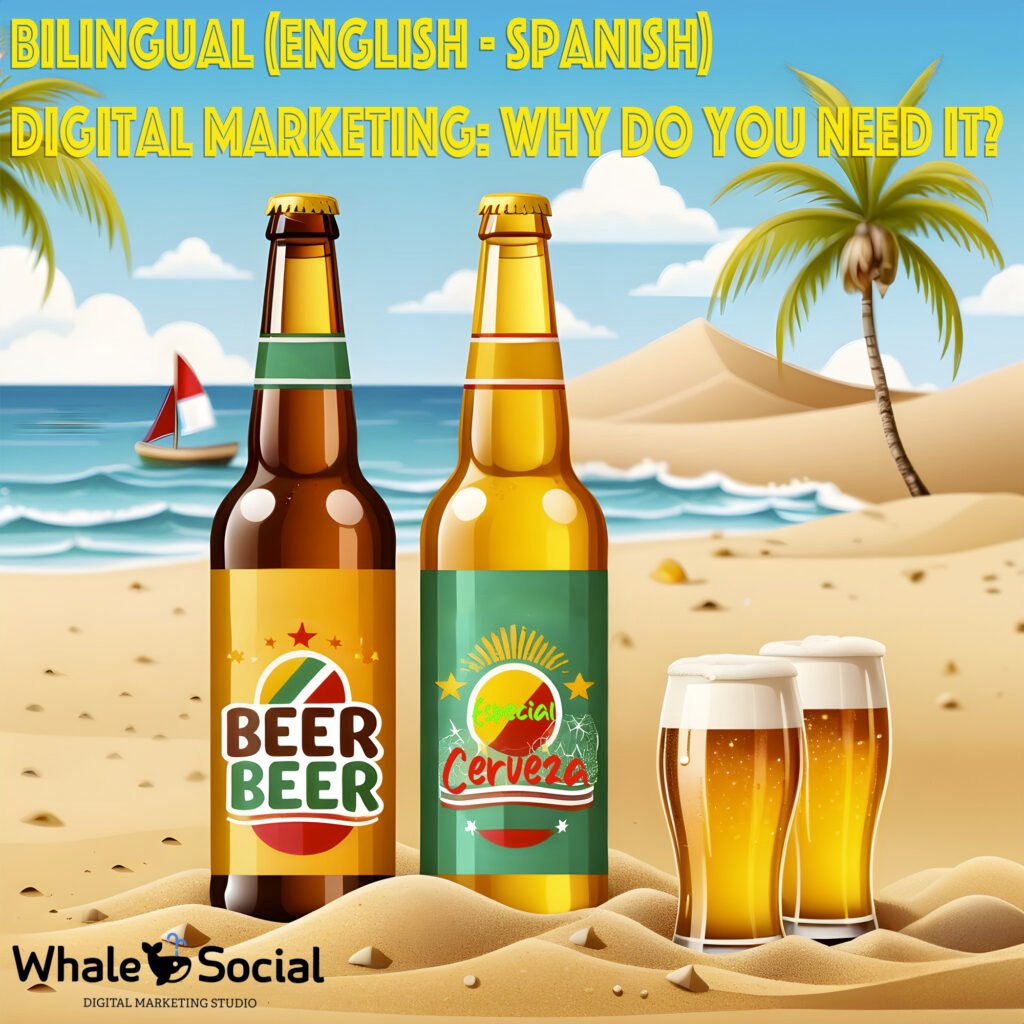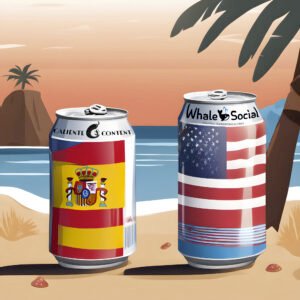By Max Milano (Tech Writer)
Bilingual (English – Spanish) Digital Marketing: Does my brand need it?
Brands and digital marketing agencies increasingly recognize the importance of connecting with customers in their language. With English and Spanish as two of the most widely spoken languages globally, the demand for bilingual digital marketing is rising.
In diverse areas like Puerto Rico, Miami, Los Angeles, New York, and Spain’s Costa Blanca, bilingual (English–Spanish) digital marketing can make a profound impact for brands, especially when adapted to local dialects and cultural nuances.
For brands seeking a lasting impact in their bilingual region, it’s not just about translating words—it’s about conveying culture, values, and identity. Hiring a natively bilingual digital marketing agency like WhaleSocial, with deep expertise in English and Spanish and their regional variations, ensures your brand effectively bridges these two influential markets.
Why a Bilingual (English-Spanish) Digital Marketing Approach Matters, and How it Can Transform Your Brand’s Outreach:

The Benefits of Bilingual Digital Marketing (English-Spanish) in Key Regions
Costa Blanca, Spain: A Hub for Tourism and Expatriates
Costa Blanca attracts both tourists and expats, especially from the UK, creating a unique need for businesses to connect with Spanish-speaking locals and English-speaking expats. A bilingual approach is essential for reaching this mixed audience effectively.
For instance, a real estate agency targeting both expats and locals would benefit from a bilingual website with property listings in both English and Spanish, using language that resonates with each group. Social media posts could feature Spanish content for local buyers and English content specifically tailored to UK and Northern European retirees or investors.
Working with a natively bilingual digital marketing agency like WhaleSocial, which understands the nuances of local Spanish dialects and British English, ensures your messaging is accurate, engaging, and meaningful to both groups.
Puerto Rico: A Spanish-Speaking Island and American Territory
Puerto Rico presents a unique case as an American territory with predominantly Spanish speakers. Many residents also speak English, especially as more people from the mainland U.S. relocate to Puerto Rico to enjoy its natural beauty and favorable tax environment.
Businesses in Puerto Rico gain significantly from a bilingual (English-Spanish) approach, as the population often fluidly moves between English, Spanish, and even “Spanglish.” For example, an e-commerce store targeting Puerto Ricans could use email campaigns, online ads, and product descriptions in both languages, even incorporating Spanglish for added local relevance.
Puerto Rican Spanish is rich with unique expressions, distinct from other varieties of Spanish. A bilingual agency like WhaleSocial, equipped with cultural insight, can adapt messaging to reflect this local flavor, fostering relatability and avoiding alienation. For example, Coca-Cola has successfully run campaigns in Puerto Rico using colloquial phrases and idioms that connect with local culture while upholding its brand identity.

Spanglish Billboard Banner Example.
Miami: The Bilingual Capital of the U.S.A.
Miami is one of the most bilingual cities in the U.S., with a large Hispanic population from Latin American countries like Cuba, Colombia, and Venezuela. This audience represents a blend of diverse Spanish dialects and cultural references, so bilingual content must appeal to both English and Spanish speakers while connecting with a multi-faceted Latin American audience.
For example, a restaurant in Miami aiming to reach both English-speaking tourists and local Hispanic residents would benefit from bilingual social media posts, ads, and a website that caters to both groups. Using phrases and imagery specific to Cuban or Colombian culture deepens connections with these communities. Major brands like McDonald’s have succeeded in Miami with bilingual campaigns that seamlessly integrate both languages for effective, tailored messaging.

Bilingual (English-Spanish) Marketing Campaign Example
Los Angeles: A Mosaic of Cultures and Languages
Los Angeles is home to a large Hispanic community with roots in Mexico, Central America, and beyond, requiring content that respects the cultural and linguistic diversity of the Spanish language. Digital content in L.A. must engage both the general English-speaking audience and the city’s Hispanic population, many of whom have Mexican and Central American backgrounds. Bilingual marketing here enables brands to resonate authentically, using local slang, cultural icons, and imagery.
An event-planning company, for instance, could use bilingual marketing to attract both English-speaking clients and those preferring Spanish. Each language offers a unique cultural approach to engagement, allowing the brand to connect authentically. Tabasco, for example, effectively uses both English and Spanish in its ads to honor Mexican cuisine’s influence on American food culture, reflecting L.A.’s vibrant cross-cultural scene.
New York: A Global City with a Large Hispanic Community
New York City’s diverse Hispanic community includes people from Puerto Rico, the Dominican Republic, Mexico, and South America. Brands targeting New Yorkers should consider bilingual or even trilingual strategies to connect with these distinct communities, which often use Spanglish to bridge language gaps.
For a brand targeting New York, bilingual content marketing could mean producing videos, blogs, and social media posts in both languages, capturing the city’s energetic multilingualism.
Coca-Cola frequently tailors its New York campaigns to reflect the city’s multicultural essence, with content that resonates with the city’s diverse population.

Taco Bell Spanglish Ad Example
Bilingual Digital Marketing Strategies by WhaleSocial
- Content Marketing: Engaging blog posts, social media updates, and video content in both English and Spanish help broaden your reach. Bilingual content that’s culturally sensitive turns readers into loyal customers.
- Social Media Marketing: Platforms like Instagram, Facebook, and YouTube are perfect for engaging bilingual audiences. Bilingual posts and videos connect with a diverse audience while demonstrating cultural awareness.
- Branding: Bilingual branding is about more than translation; it’s about understanding cultural identities. Working with a bilingual agency allows your brand to deliver a consistent, culturally resonant message. For example, McDonald’s “I’m Lovin’ It” translates effectively to “Me Encanta,” preserving the upbeat tone in Spanish.
- SEO: A bilingual approach to SEO lets you optimize for both English and Spanish keywords, ensuring local relevance. A business in Miami, for instance, could optimize for “restaurantes en Miami” and “restaurants in Miami,” so users find the brand in either language.
- Pay-Per-Click (PPC) Advertising: Bilingual ad campaigns on Google and social media help brands reach English and Spanish speakers. With PPC ads in both languages, brands increase relevance, expand their audience, and lower ad spend.
Why Choose a Bilingual Agency Like WhaleSocial?
Choosing a bilingual digital marketing agency is about more than language skills; it’s about cultural fluency and marketing expertise. A bilingual agency like WhaleSocial, with extensive experience creating campaigns that resonate with both English-speaking and Hispanic audiences, offers unmatched advantages. Their bilingual team understands both the linguistic and cultural nuances that define each Spanish-speaking community.
For businesses in Costa Blanca, Puerto Rico, Miami, Los Angeles, or New York, bilingual (English-Spanish) digital marketing is essential. By partnering with a bilingual agency, your brand connects more authentically with diverse Hispanic and Anglo audiences, expanding reach and maximizing each campaign’s potential.
Contact WhaleSocial today for a free 30-minute consultation to discuss your marketing needs.





